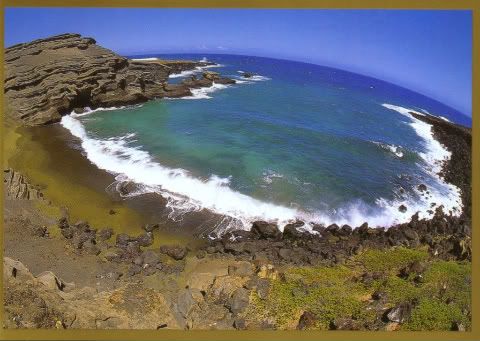 Photo by Michael Stewart
Photo by Michael StewartPapakolea Beach (also known as Green Sand Beach, Mahana Beach and, erroneously, Puʻu Mahana) is a green sand beach located at South Point, in the Kaʻu district of the island of Hawaiʻi. One of only two green sand beaches in the United States, the other being in Guam, the beach gets distinctive coloring from olivine crystals found in a nearby cinder cone.
Papakolea Beach is located in a bay circled by Puʻu Mahana, a cinder cone formed over 49,000 years ago and associated with the southwest rift of Mauna Loa. Since its last eruption, the cinder cone has partially collapsed and been partially eroded by the ocean.
The cinder cone is rich in olivine, a silicate mineral containing iron and magnesium, also known as peridot when of gem quality. Olivine is a common mineral component of Hawaiian lavas and one of the first crystals to form as magma cools. Olivine is locally known as "Hawaiian Diamond" and is notably found in Oʻahu's famous Diamond Head landmark.
Papakolea灘(也稱為青砂灘,默哈納灘或普奧默哈納)是一個綠色的沙灘,位於夏威夷大島的最南端。美國僅有的兩個綠色的沙灘,另一個是在關島,因含橄欖石而形成獨特的沙灘色。
夏威夷熔岩的礦物成分中常見橄欖石,含有鐵,鎂。當地人稱橄欖石為“夏威夷鑽石”,特別是在瓦胡島著名的鑽石山。
References sources : wikipedia
沒有留言:
張貼留言